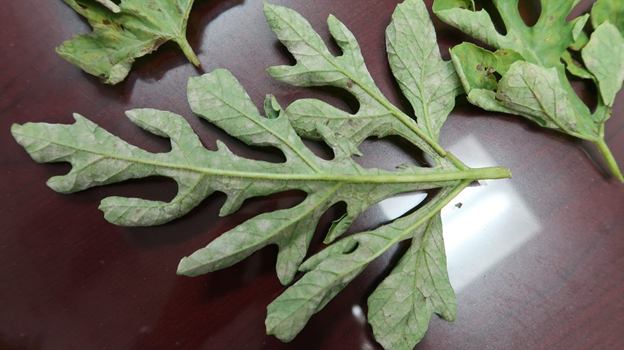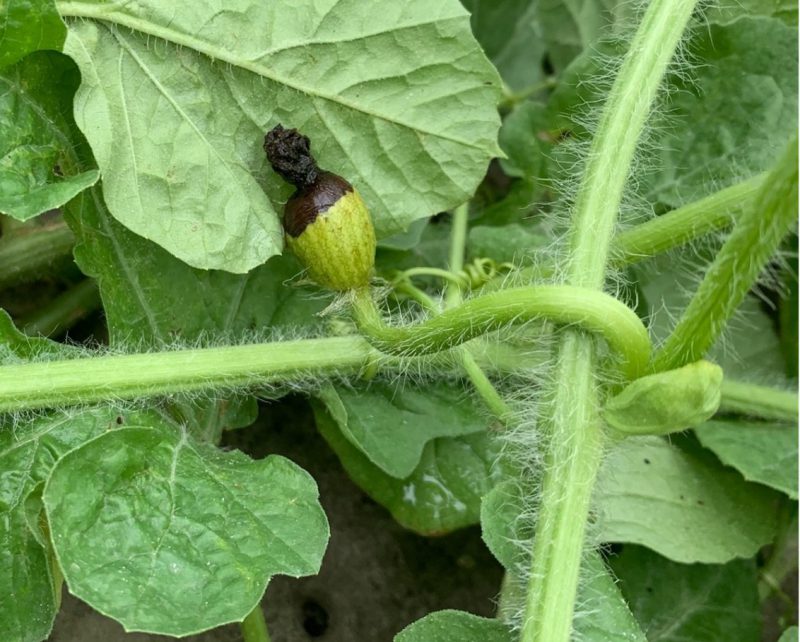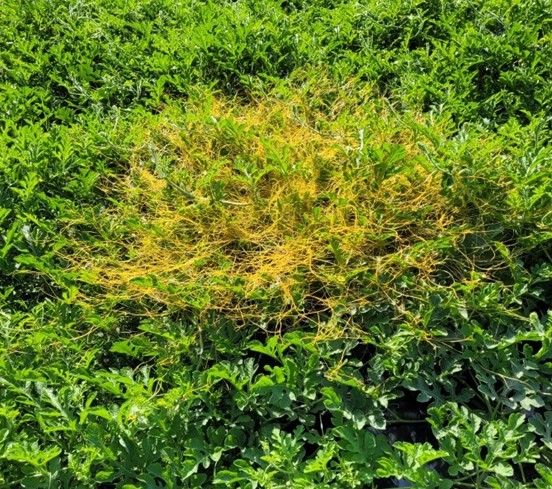UF/IFAS Extension Suwannee Valley Weekly Watermelon Crop Update. These updates are summarized by Bob Hochmuth with input from Suwannee Valley Extension Agents: Mark Warren, Tyler Pittman, Tatiana Sanchez, Luke Harlow, Jay Capasso, Sylvia Wills, Dan Fenneman, Keith Wynn, Danielle Sprague, Kevin Athearn, and Charles Barrett.
–
First Confirmation This Year of Powdery mildew
This is typically the time in the season when powdery mildew is active and early management is the only effective approach to control. Late last week, Tatiana Sanchez confirmed powdery mildew in the Suwannee Valley region. With powdery likely hot on our heels now, and because we are past the proactive/preventative approach with Miravis Prime, we are now at the stage of rotating targeted products such as Procure or Quintec in combination with broad spectrum fungicides such as Mancozeb. Inspire Super has some control of powdery mildew, but with known powdery mildew pressure in the region, you should add one of the targeted materials for powdery mildew.
Initial symptoms appear as circular yellow areas on the leaves. As the infection progresses, powdery growth of the fungus appears and can be seen initially on the underside of the leaves (see photo). Eventually the “white powder” can be found on both surfaces of the leaves and stems as the tissue decays. (Summary by Tatiana Sanchez).
–
Disease Update
Reports this past week were frequent regarding high pressure and outbreaks of gummy stem blight. We sent an Alert for gummy stem blight last week on May 13th with more details, so refer back to that issue for the details. Affected fields can be found throughout the region. Lesions can form on the stem that enlarge and girdle the main stem. Black fruiting bodies of the fungus are often visible on the infected leaves, stems, and fruits and serve in confirmatory diagnosis. If your fields have not been sprayed specifically for gummy stem blight, we URGE you to apply an application of Inspire Super immediately because it is the top-rated fungicide in our UF/IFAS research trials.
We have not received a confirmation of downy mildew, but we continue to be on the lookout. Bacterial activity also has been very low in the last week. (Summary provided by Bob Hochmuth).
–
“Kicking Fruit” (Aborting fruit)
There have been several questions this past week regarding “kicking fruit”. The situation in question is from fields with some very small fruit (1-3 days old) that have been aborted or “kicked” (see photos). Fruit abortion can result from poor pollination, plant stress (dry soils, water-logged soils, extremely high or low temperatures), low light conditions, and can also occur in extremely high nitrogen levels or very low nitrogen levels. However, once a plant sets 2-3 fruit, it may abort fruit because the plant cannot support any more at that time. A single plant will form a dozen or more female fruit flowers, so fruit abortion is a normal process – you don’t ever see that many fruit set on a single plant. So, what can you do? My suggestion is to try to keep things at optimum levels and avoid extremes. These aborted fruits begin to decay on the blossom-end but should not be mistaken for blossom-end rot. In fact, blossom-end rot (a calcium distribution problem) is actually rare in watermelons in the Suwannee Valley, largely due to the fact our irrigation water has 70-80 ppm calcium, about half of the entire plant needs, provided every day, multiple times per day. The main thing to realize is that a watermelon plant simply cannot set a fruit at each female bloom. It is not going to happen, therefore, fruit abortion at times during the season should be expected. Here is a little math exercise to demonstrate my point. If you have about 2,000 plants per acre and harvest and sell two fifteen-pound watermelons per plant, the yield is 60,000 pounds per acre. Of course, not all plants survive and not all plants produce marketable fruit, but you get the idea. Thinking that you need to “set” 4-5 or more fruit per plant to do well is simply not the case. Once you start harvesting, a plant may begin to set fruit again since the fruit load has been reduced at that time but let’s worry about that later (by Bob Hochmuth).
–
Dodder- Ever Seen It?
This is an interesting and sort of bonus topic this week. Dodder is a parasitic plant or vine in the genus, Cuscuta. It is also commonly called strangle weed, hairweed, hellbine, or angel’s hair (see photo below). There are 150 different species throughout the world with ten species identified in Florida. It is not commonly seen in watermelon fields but is not rare either. I usually see at least one citing per year and is noted because it is so strange looking. Dodder vine is a leafless, parasitic weed relying on its host for survival. Once fully established, thick mats of dodder stems can completely cover a host plant. The stems of dodder are very thin. As the plant matures, it may become a golden yellow or remain a yellowish-green color. Dodder produces very little to no chlorophyll (the green color pigment in leaves) and relies upon its host for water and nutrients. The portion of the stem connected to the soil degrades as the vine migrates up, dodder has no true roots. In order to attach to a host plant, dodder forms specialized structures called “haustoria” which invade the vascular tissues of host plants and allow the dodder plant to utilize nutrients and water from the host plant, eventually being free of the soil and reattaching itself completely to the host plant. (compiled by Bob Hochmuth and Luke Harlow, from reference https://edis.ifas.ufl.edu/ep556)
–
Nutrient Management Update
Most conventionally fertilized fields are at the stage of growth where the fertigation rates likely should be 2.0- 2.5 lbs per acre per day for nitrogen and potassium, using the net acres of watermelons in the field (not including drive middles and other non-cropped areas in the field). Once we start harvests, it is common to set the rate at 2.0 lbs per acre per day and leave it there until one week from last pick. This amount can be fine-tuned with the use of our petiole-sap testing program offered as a service by Extension agents in this region. (summary by Bob Hochmuth)
–
Rindworm
We continue to receive a few confirmations of rindworms feeding. As a reminder, the better materials will include the higher labeled rates Intrepid or Coragen (as a spray only) which are also safe to pollinators. Do not use pyrethroids (bifenthrin, Asana, Lambda, etc.) for control of rindworms as there is a very high level of resistance to that class and they are very toxic to bees.
–
Join the Florida Watermelon Association
It is the mission of the Florida Watermelon Association to support research, education and promotion of the fresh Florida watermelon industry. If you are not a current member, I encourage you to join. Your voice as a watermelon farmer needs to be heard on so many issues, now more than ever. All watermelon farmers and allied industry representatives should join. I am a member, and I encourage every reader of this weekly update to join as well. To join, go to https://www.flfwa.com/
–
Thank You to the Suwannee Valley Rapid Diagnostic Watermelon Program and Its Industry Sponsors
UF/IFAS Extension agents have initiated a more formal way to support our watermelon growers with a rapid diagnostics system through Suwannee Valley Regional. This industry-funded program allows Extension Agents to submit and pay for watermelon grower plant disease and other diagnostic samples. This SV Rapid Diagnostic Watermelon Program will help us to get quicker diagnostic results and not have to charge the growers directly. Plant disease samples are typically $40 and leaf tissue analyses are typically $20. We want to thank the initial sponsors of this program: Syngenta Crop Protection, Harrell’s Fertilizer, Koppert Biological Systems, SEEDWAY LLC, BASF Vegetable Seeds, Bayer Crop Science, Gowan Seed, and Gowan USA for sponsoring this effort. Other industry reps interested in sponsoring this effort can contact Bob Hochmuth at bobhoch@ufl.edu or 386-288-6301.
- 2024 Watermelon Season Wrap Up - June 21, 2024
- Weekly Watermelon Update – June 3 - June 7, 2024
- Weekly Watermelon Update #10 – May 20 - May 24, 2024



